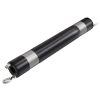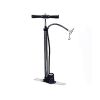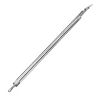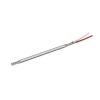Solinst Model 800 Low Pressure Packers
Features
- Designed for isolating discrete zones for short-term monitoring
- Ideal for use with Solinst Bladder Pumps or Double Valve Pumps
- Inflated using a hand pump up to 50 psi
- Free ground shipping
- Expedited repair and warranty service
- Lifetime technical support
- More
Overview
The Solinst Model 800 Low Pressure Packers inflate with a hand pump and are available in 1.8" and 3.9" (46 mm and 99 mm) diameters. Typical inflation pressures for the 1.8" (46 mm) packers are from 20–40 psi (140–275 kPa) above hydrostatic pressure, and from 20–30 psi (140–205 kPa) for the 3.9" (99 mm) packers.
Design
The Packers utilize a gland of black carbon reinforced rubber (BCR) on a Sch 80 PVC body. They are lowered on a support cable or a rigid PVC drop pipe. The inflation line is standard LDPE tubing and connects to the packers using a simple push fitting.
Applications
Primarily for short-term use in 2" and 4" (51 mm and 102 mm) monitoring wells, they can also be used in smooth boreholes and wells with 1.9–5" (48–127 mm) inside diameters. If a rigid drop tube is not required for the application, it is recommended that a safety line be attached to the eyebolt provided. The Solinst Model 103 Tag Line provides a convenient, graduated support cable that can be used for this purpose, as well as for measuring placement depth.
Use
Solinst packers are ideal for use with Solinst Bladder Pumps or Double Valve Pumps, which can be easily attached above the packers. The water inlet can be below a single packer, or through perforated pipe fitted between straddle packers. For hydraulic conductivity testing, Solinst Leveloggers can also be suspended, either below or between packers, from the eyebolt on the bottom of the packer.
In The News
New map shows significant groundwater depletion in Central California
Groundwater level data collected by a Central California county shows significant drops during the past 12 years, according to a San Luis Obispo Tribune article. Data shows that groundwater has dropped by a minimum of 70 feet from 1997 to 2009 in the Paso Robles area of Central California. In the past four years the areas of most significant decline have expanded north and south. Drought and agricultural withdrawals are the likely culprits for the groundwater decline. Some advocates are calling for more responsible water use by vineyards in the area, while farmers note that the recent drought did not help the situation.
Read MoreWave-Powered Buoy Deployed in Puget Sound
While the development of solar-powered monitoring systems has improved access to real-time environmental data, solar power is still limited by low light conditions, such as poor weather, nighttime, or high-latitude environments. To supplement these incumbent power solutions at sea, Ocean Motion Technologies has developed a small-scale ocean wave energy system that can be directly integrated with existing data buoy platforms. Not only does wave energy supplement solar power during periods when the buoys are limited by light availability, but it also allows data buoys to perform beyond their current power capacities.
Read MoreLong-Term Monitoring in the Chautauqua Lake Watershed
With a widely developed shoreline, Chautauqua Lake experiences influxes of non-point source pollution that have historically impacted the health of the lake. The Chautauqua Lake Association (CLA) has been monitoring the lake for over two decades, reporting on changes that have occurred over the years. A pair of local lake advocates, Jane and Doug Conroe, have lived on the lake for over 40 years and have played an important role in establishing monitoring programs and facilitating consistent data collection throughout the watershed. Doug has been involved with the Chautauqua Lake Association (CLA) since the pair moved to the area in 1980, and is currently serving as the Executive Director.
Read More



























